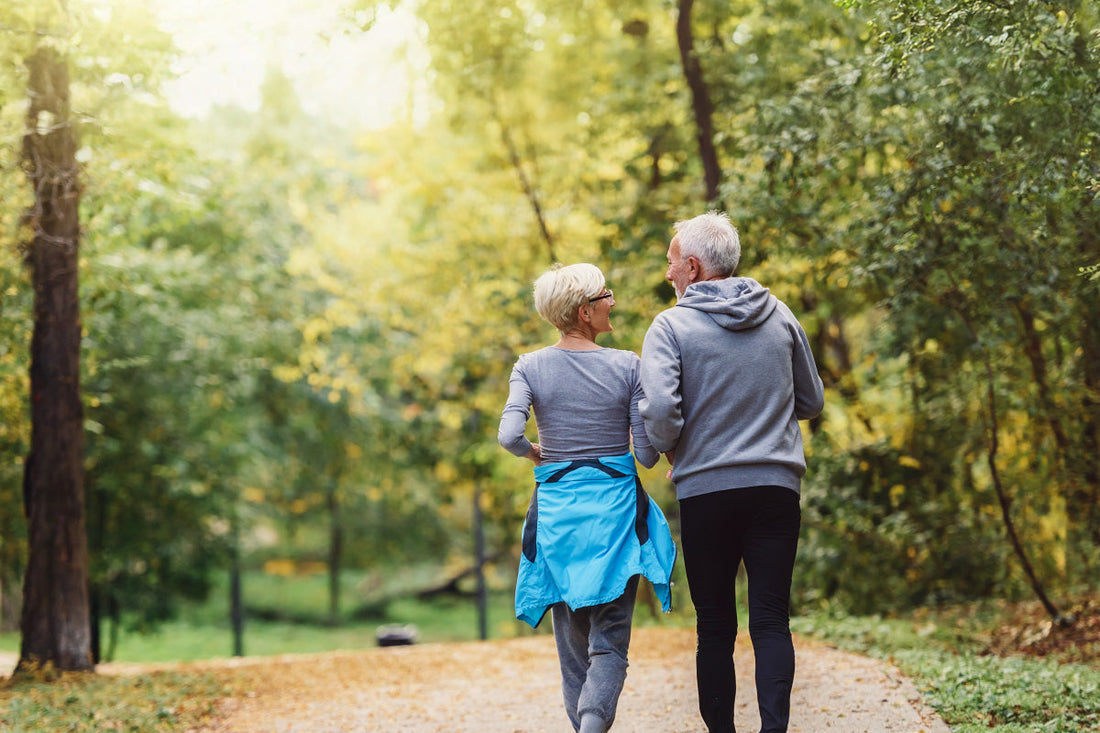
Purification pour la longévité : une base holistique pour un vieillissement en bonne santé
Dr. Miranda Wiley, B.Sc., NDPartager
L'autre jour, on écoutait de la musique en voiture pendant que je conduisais ma fille et ma mère pour faire des courses . La chanson « 22 » de Taylor Swift est passée et j'ai demandé à ma fille de six ans et demi… Ma fille me demanda si 22 ans paraissait vieux . « Oh oui, c'est vraiment vieux ! » répondit-elle . Ma mère septuagénaire et moi avons souri et soupiré avec regret… Que ne donnerions -nous pas pour être à nouveau aussi vieux/jeunes !
L'âge est en partie un état d'esprit, en partie une accumulation de sagesse et en partie une représentation de la façon dont nous vivons notre vie. quotidiennement , tandis que La « longévité » désigne simplement le nombre d'années que nous vivons . Pour les patients que j'accompagne , l'objectif est de vieillir en bonne santé . Il ne s'agit pas seulement d'allonger notre espérance de vie, mais de préserver notre qualité de vie tout au long de notre existence. J'ai vu de jeunes adultes présenter de nombreux symptômes de vieillissement – douleurs articulaires, troubles de la mémoire ou de la cognition, peau abîmée, fatigue – et j'ai travaillé avec des personnes âgées d'une vitalité et d'une énergie inspirantes, pleinement investies dans la vie et leur communauté, et qui semblent défier le temps ! Je sais lequel je veux être !
Ce que nous ne pouvons pas contrôler en matière de vieillissement
Avoir de bons gènes est un atout, mais on estime que seulement 25 % de notre santé à long terme est due à l'influence génétique ( 1) . Les 75 % restants, qui expliquent la différence entre les personnes du même âge considérées comme « jeunes » et celles considérées comme « âgées », semblent être multifactoriels, et nombre de ces facteurs peuvent être modifiés . C'est une excellente nouvelle, car cela nous donne une certaine influence sur la qualité de notre vieillissement !
Le genre joue assurément un rôle dans le processus de vieillissement . La puberté commence plus tôt chez les personnes nées de sexe féminin (chromosomes XX) que chez celles nées de sexe masculin (chromosomes XY), et les femmes cisgenres ont généralement une espérance de vie qui est 4 ans de plus que les hommes cisgenres ( 2 ) . Les recherches sur le vieillissement de la population transgenre sont en cours avec des données limitées à l'heure actuelle ( 3 ) .
6 choses que nous POUVONS contrôler concernant le vieillissement !
La bonne nouvelle, c'est que si l'on ne peut arrêter le vieillissement, on peut le ralentir. Poursuivez votre lecture pour découvrir 5 astuces nutritionnelles et de style de vie à mettre en pratique dès aujourd'hui pour vieillir en beauté !
1. Ce que nous mangeons
Puisque chacune de nos milliards de cellules est constituée d'aliments ingérés, il est logique qu'une alimentation plus saine contribue à une meilleure santé. Préférez-vous que votre corps soit nourri de frites ou d'un bon repas familial fait maison ?

La qualité de notre alimentation reflète à la fois la densité calorique et la densité nutritionnelle des aliments . Des études ont démontré à maintes reprises que la restriction calorique a un effet très positif sur le vieillissement cellulaire , en améliorant la sensibilité à l'insuline et en abaissant la glycémie à jeun ( 4) .
Cependant, la réduction de l’apport en nutriments ainsi que des calories peut potentiellement avoir un effet négatif sur le vieillissement en favorisant la perte osseuse et la perte musculaire ( 5) . Par conséquent, les aliments riches en nutriments et à faible valeur calorique favorisent davantage un vieillissement en bonne santé que les aliments riches en calories et pauvres en nutriments.
Conseil de pro !
Parmi les exemples d'aliments complets peu caloriques et riches en nutriments, on peut citer les céréales complètes, les haricots et les légumineuses, ainsi que les fruits et les légumes. Je recommande de les intégrer à chaque repas et collation jusqu'à ce que vous suiviez la règle du « 80/20 », c'est-à-dire que vous consommez de vrais aliments 80 % du temps (et que vous vous offrez des aliments plus caloriques et pauvres en nutriments 20 % du temps ou moins).
2. Quand nous mangeons
Le lien entre l’obésité et la mortalité, via les maladies dites « occidentales » courantes, notamment les maladies cardiovasculaires, les maladies métaboliques (dont le diabète) et les cancers, est de plus en plus évident ( 6) . Ceci conforte l’idée que la gestion de la glycémie et de l’insuline est essentielle pour bien vieillir.
Le moment où nous mangeons a autant d'influence sur notre glycémie et notre taux d'insuline que ce que nous mangeons . Manger régulièrement, même des aliments sains comme des fruits et légumes frais, des noix et des graines, empêche une chute de la glycémie et de l'insulinémie . Intégrer de courts jeûnes entre les repas – c'est-à-dire prendre 2 à 4 repas par jour toutes les 3 à 5 heures sans grignotage – est une première étape simple pour de nombreuses personnes souhaitant améliorer leur sensibilité à l'insuline .
Conseil de pro !
Essayez ce programme alimentaire :
- Petit-déjeuner – 7h
- Déjeuner – Midi
- Dîner – 17h
Ce programme peut également être adapté à votre style de vie, tout en conservant les intervalles suggérés entre les repas, par exemple :
- Petit-déjeuner – 8h
- Déjeuner – Midi
- Collation légère avant l'entraînement – 15h30
- Dîner – 19h
Certaines personnes constatent qu'elles ont une meilleure digestion et une plus grande clarté mentale lorsqu'elles rompent leur jeûne à 11 heures et prennent leur deuxième et dernier repas de la journée entre 17 h et 18 h . Vous avez peut - être remarqué que ces horaires prévoient peu ou pas de grignotage – bien que le grignotage soit une norme culturelle pour beaucoup , il est aussi un facteur de mode de vie courant et modifiable qui peut avoir un impact sur de nombreux problèmes de santé et leur résolution.
La première étape de tout changement est la prise de conscience . Commencez simplement par prêter attention à l'heure à laquelle vous mangez et à la sensation de faim qui apparaît ensuite . Si vous avez faim une à deux heures après avoir mangé , il est probable que votre glycémie soit mal régulée.

Vous devrez peut-être modifier votre alimentation – moins de glucides raffinés, plus de protéines, plus de matières grasses, plus de fibres, plus de liquides – ou vous devrez peut-être manger moins à chaque repas , afin d'espacer les repas .
Les recommandations diététiques du kit Wild Rose peuvent constituer un grand pas en avant vers une meilleure gestion de la glycémie, car les aliments sont non transformés, équilibrés et riches en nutriments et en fibres pour favoriser la satiété.
Restreindre les heures où nous mangeons
Le changement de paradigme suivant en matière d'alimentation passe par l'alimentation à horaires restreints (AAR) et le jeûne intermittent (JI) . Dans l'AAR, la « fenêtre d'alimentation » et la « fenêtre de jeûne » de chaque jour sont fixes et limitées à un nombre d'heures déterminé.
Un point de départ est 12h12 – manger dans un intervalle de 12 heures La fenêtre d'alimentation et de jeûne s'étend sur une période de 12 heures . À partir de là , on peut expérimenter des fenêtres d'alimentation plus courtes et des fenêtres de jeûne plus longues . Les ratios populaires sont 14:10 et 16:8, car ils offrent une certaine flexibilité et permettent les repas en groupe .
Le jeûne intermittent désigne plus précisément des périodes de jeûne d'une journée entière ou plus. L'eau, les tisanes et même le bouillon d'os sont autorisés les jours de jeûne, mais aucun aliment solide n'est consommé . Je recommande généralement de commencer par une période de jeûne intermittent (TRE) et de passer ensuite au jeûne intermittent si on le souhaite .
Pour les personnes souffrant de problèmes de santé actuels , comme le diabète , il est toujours préférable de collaborer avec un professionnel de la santé familier avec le jeûne, qui pourra surveiller les progrès et les effets secondaires potentiels pendant un jeûne . Le jeûne peut être extrêmement dangereux dans certains cas , il est donc important de vous faire accompagner par une personne capable de suivre et de vous guider dans votre démarche, en tenant compte de votre sécurité et des résultats à long terme.
Bien que le TRE et le IF puissent tous deux être utiles pour réguler la glycémie et les niveaux d'insuline, l'avantage supplémentaire du IF est que, grâce au jeûne complet, le corps entre finalement dans un état d'autophagie, ce qui se traduit par « auto-alimentation ». C'est un processus naturel par lequel le corps décompose les déchets et recycle ces éléments afin que les tissus puissent se régénérer .
Un jeûne plus long pourrait être une option à envisager en dehors d'une cure détox. Encore une fois , veuillez consulter votre professionnel de santé avant d'entreprendre un jeûne de plus d'une nuit !
3. Notre alimentation
Notre façon de manger influence également notre capacité à choisir des aliments de meilleure qualité et à manger jusqu'à satiété . Manger à table, en compagnie , et apprécier le repas tout en discutant ralentit notre rythme et nous permet de manger moins, car nous sommes rassasiés plus rapidement.
Lorsque nous mangeons sans réfléchir – en travaillant, en regardant la télévision, en conduisant – nous avons tendance à manquer le signal de notre corps indiquant la satiété et nous mangeons inconsciemment trop ( 7) .
À Okinawa, au Japon , où vivait autrefois une forte concentration de centenaires en pleine santé, agiles et vifs d'esprit (avant l'arrivée du régime occidental) , il existe un proverbe : « Hara Hachi Bu ». Cela signifie qu'il faut manger jusqu'à être rassasié à 80 % puis s'arrêter jusqu'au prochain repas. En d'autres termes, c'est la sagesse de se nourrir correctement tout en évitant les excès .

Conseil de pro !
Après votre repas, essayez de faire une pause et de simplement vous asseoir avant de vous resservir. Cela permettra à votre cerveau de digérer et vous réaliserez peut-être que vous n'avez plus faim !
4. Comment nous vivons
Stress positif
La plupart d'entre nous connaissent l'adage « Ce qui ne nous tue pas nous rend plus forts ». Le terme médical correspondant est « hormèse ». Une exposition régulière et périodique à des niveaux de stress sublétaux – un bain d'ours polaire dans une eau froide de temps à autre, la présence de composés amers dans les aliments, la privation calorique, un exercice physique intense – renforce notre vitalité et nous rend plus résistants et adaptables face au stress imprévu.
Connexions sociales
Dans les « zones bleues » du monde, des régions de la planète abritant de fortes concentrations de populations âgées en bonne santé et dynamiques et de nombreux centenaires (y compris Okinawa, au Japon), la communauté sociale s’est avérée être un facteur prédictif de longévité… et de qualité de vie ( 8) .
Conseil de pro !
Prenez le temps aujourd'hui de contacter un proche, simplement pour maintenir le lien . Cela pourrait vous être utile, et s'il s'agit d'une personne âgée, cela pourrait être absolument essentiel pour elle !
Activité et exercice
L’exercice physique modéré est une autre façon économique de favoriser la longévité ( 9) . Le meilleur exercice est celui que vous appréciez ; trouvez donc une activité que vous aimez – marche, jardinage, danse, natation, yoga – et faites-en une priorité dans votre vie.

5. Notre état d'esprit
Comme le disait Oscar Wilde, les seules certitudes dans la vie sont la mort et les impôts . La mort est inévitable , aussi l'objectif est-il de « compresser sa mortalité » : être aussi en bonne santé , dynamique et plein de vie que possible jusqu'à nos derniers instants , et éviter une longue et pénible dégradation de la santé et de la qualité de vie à mesure que nous approchons de la fin.
Honorons l'équilibre qui imprègne chaque jour et chaque année de nos vies glorieuses ! Le soleil se lève et se couche . De même, nous sommes actifs et nous dormons en alternance tout au long de ce rythme quotidien, et ce, durant toute notre existence.
Ce rythme quotidien d'activité et de repos se retrouve également dans les saisons annuelles : le grand ménage de printemps, les activités estivales, les récoltes d'automne et le confort hivernal…

Notre corps reflète la planète sur laquelle nous vivons et nous y épanouissons en harmonie. Nous mangeons pour compléter nos nutriments, réparer les dommages, produire des neurotransmetteurs et grandir. Nous transpirons, urinons et allons à la selle pour éliminer les déchets indésirables et potentiellement nocifs de notre organisme .
Construire un peu, purifier un peu, et recommencer… En termes médicaux , le « métabolisme » englobe à la fois l’« anabolisme » (construction) et le « catabolisme » (dégradation). Nous avons besoin des deux , dans un rythme alterné . afin d' améliorer notre espérance de vie en bonne santé !
6. Notre méthode de purification
Dans notre monde occidental moderne et avec un accès généralement excessif à la nourriture (fraîche et biologique, mais aussi raffinée et dénaturée), la purification n'est pas aussi ancrée dans nos vies qu'elle l'était pour nos ancêtres .
Prendre le temps de « nettoyer sa maison » consciemment en modifiant son alimentation, en augmentant sa consommation de liquides, en transpirant grâce à l'exercice physique ou au sauna, et en utilisant un mélange d'herbes soigneusement sélectionné. – comme le kit de détoxification à base de plantes Wild Rose – est un rituel important pour favoriser l’élimination des toxines, permettre au corps de se débarrasser de ce qui ne nous sert plus et laisser place à la santé et aux bonnes habitudes.
Conseil de pro !
Nettoyer périodiquement (à prendre en compte selon les saisons ) avec des herbes utilisées depuis des siècles, dans les kits Wild Rose D- Tox utilisés depuis des décennies !
Vivre pour la longévité
La longévité et le vieillissement en bonne santé ne dépendent pas d'un seul facteur. Nous avons besoin d'une alimentation saine, d'un sommeil réparateur, de liens sociaux, d'activité physique, de joie, d'un stress (idéalement positif !), d'alterner jeûne et alimentation, et d'une détoxification régulière, ponctuée de cures de détoxification plus intensives, pour bien vieillir. Chaque petit pas que vous faites aujourd'hui, et que vous développerez par la suite, sera bénéfique pour votre avenir au sein de votre communauté.
Références
- vB Hjelmborg J, Iachine I, Skytthe A, Vaupel JW, McGue M, Koskenvuo M, Kaprio J, Pedersen NL, Christensen K. Influence génétique sur la durée de vie et la longévité humaines. Hum Genet. 2006 avr;119(3):312-21. doi : 10.1007/s00439-006-0144-y. Epub 2006 févr 4. PMID: 16463022.
- https://www150.statcan.gc.ca/n1/pub/82-003-x/2018004/article/54950-eng.htm
- Castruita PA, Piña-Escudero SD, Rentería ME, Yokoyama JS. Facteurs génétiques, sociaux et liés au mode de vie influençant le vieillissement en bonne santé et la longévité. Curr Genet Med Rep. 2022 sept. ; 10(3) : 25-34. doi : 10.1007/s40142-022-00205-w. Publication en ligne : 26 sept. 2022. PMID : 38031561 ; PMCID : PMC10686287. Ceolin C, Papa MV, Scala A, Sergi G, Garolla A. Vieillir dans le genre désiré : revue systématique des maladies liées au vieillissement chez les personnes transgenres. J Endocrinol Invest. 2024 août ; 47(8) : 1851-1862. doi : 10.1007/s40618-024-02353-y. Publication en ligne : 21 juin 2024. PMID : 38904914 ; PMCID : PMC11266207.
- Redman LM, Ravussin E. Restriction calorique chez l'humain : impact sur les paramètres physiologiques, psychologiques et comportementaux. Antioxid Redox Signal. 15 janv. 2011 ; 14(2) : 275-87. doi : 10.1089/ars.2010.3253. Publication en ligne : 28 août 2010. PMID : 20518700 ; PMCID : PMC3014770.
- Dakic T, Jevdjovic T, Vujovic P, Mladenovic A. Moins on mange, plus on vit longtemps : la restriction calorique peut-elle nous aider à devenir centenaires ? Int J Mol Sci. 2022 Jun 11;23(12):6546.
- Blüher M. Aperçu des complications liées à l'obésité : données épidémiologiques établissant un lien entre le poids corporel et d'autres marqueurs de l'obésité et les conséquences néfastes sur la santé. Diabetes Obes Metab . 2025 avr;27 Suppl 2(Suppl 2):3-19. doi : 10.1111/dom.16263. Epub 2025 mars 11. PMID : 40069923 ; PMCID : PMC12000860. doi : 10.3390/ijms23126546. PMID : 35742989 ; PMCID : PMC9223351.
- Ruda I, Chellapandian DC, Rott M, Scheid S, Freiherr J. Au-delà de l'alimentation distraite : la distraction cognitive diminue la perception agréable des odeurs et interagit avec le poids. Nutrients. 2024 Aug 27;16(17):2871. doi : 10.3390/nu16172871. PMID: 39275187; PMCID: PMC11397456.
- Table ronde sur l'amélioration de la santé des populations ; Conseil sur la santé des populations et les pratiques de santé publique ; Institut de médecine. Engagement des entreprises dans la construction de communautés saines : résumé de l'atelier. Washington (DC) : National Academies Press (États-Unis) ; 8 mai 2015. 2. Leçons tirées des Zones bleues®. Disponible sur : https://www.ncbi.nlm.nih.gov/books/NBK298903/
- Lee DH, Rezende LFM, Joh HK, Keum N, Ferrari G, Rey-Lopez JP, Rimm EB, Tabung FK, Giovannucci EL. Intensité de l'activité physique de loisir à long terme et mortalité toutes causes confondues et par cause spécifique : une cohorte prospective d'adultes américains. Circulation. 16 août 2022 ; 146(7) : 523-534. doi : 10.1161/CIRCULATIONAHA.121.058162. Publication en ligne : 25 juillet 2022. PMID : 35876019 ; PMCID : PMC9378548.
About the author

Dr. Miranda Wiley, B.Sc., ND
Dr. Miranda Wiley is a Vancouver-based Naturopathic Doctor and graduate of the Boucher Institute in New Westminster. She has over 30 years experience in the Natural Health industry and sees clients in BC, both in person and virtually.

